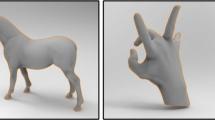Abstract
LOD (Level of Detail) models are widely used recently to accelerate the rendering of 3D scenes. An algorithm that creates multiple levels of detail for 3D scene by merging near-coplanar faces is presented in this paper. First a Gauss sphere is defined for the model of scene and it is divided into meshes near-uniformly. Then, the faces of objects are attached to the respective spherical meshes according to their normal direction. If faces attached to the same mesh are connected with each other, they are merged to form a near coplanar patch (Superface). Isolated vertices inside the patch are removed and the patch is retriangulated. To further improve the simplification, vicinity vertices on the boundary of the surface patch are merged. In the algorithm, a planar separate rule planar-enneatree is adopted to set up a hierarchical structure of the Gauss sphere, which is used to support the hierarchical model of the scene (LOD). The experimental result shows that the algorithm can achieve desired simplification effects.
Similar content being viewed by others
References
Clark James H. Hierarchical goemetric models for visible surface algorithm.Communications of the ACM, 1976, 19(10): 547–554.
Pan Zhigeng, Ma Xiaohu, Shi Jiaoying. The automatic generation algorithm for models at multiple levels of detail in virtual environment.Journal of Software, Sept., 1996, 7(9): 526–531. (in Chinese)
Liu Xuehui. Research on multiple levels of detail generating for 3D complex objects used in virtual reality [dissertation]. Institute of Software, The Chinese Academy of Sciences, Jan., 1998.
Kalvin A D, Taylor R H. Superfaces: Polygonal mesh simplification with bounded error.IEEE C.G. & A., 1996, 16(3): 64–77.
Finkelstein A, Jacobs C E, Salsin D H. Multiresolution video. InSIGGRAPH’96, 1996, pp. 281–290.
Greg Turk. Re-tiling polygonal surfaces.Computer Graphics, July, 1992, 26(2): 55–64.
Rossignac J, Borrel P. Multi-Resolution 3D Approximation for Rendering Complex Scenes. In: Geometric Modeling in Computer Graphics, Falcidieno B, Kunii T (eds.) New York: Springer Verlag, 1993, pp.455–465.
Michael Garland, Paul S Heckbert. Surface Simplification Using Quadric Error Metrics. SIGGRAPH’97, 1997, pp.209–216.
Luebke D, Carl Erikson. View-dependent simplification of arbitrary polygonal environments. InProc. ACM Computer Graphics, Annual Conference Series (SIGGRAPH’97), 1997, pp.217–224.
J Michael Lounsbery. Multiresolution analysis for surfaces of arbitrary topological type [dissertation]. Department of Computer Science and Engineering, University of Washington, September, 1994.
Matthias Eck, Tony DeRose, Tom Duchampet al. Multiresolution Analysis of Arbitrary Meshes. InSIGGRAPH’95, 1995, pp.173–182.
William J Schroeder, Jonathan A Zarge, William E Lorensen. Decimation of triangle meshes.Computer Graphics, July, 1992, 26(2): 65–70.
Hugues Hoppe, Tony DeRose, Tom Duchampet al. Mesh optimization. InSIGGRAPH’93, Aug., 1993, pp.19–26.
Ronfard R, Rossignac J. Full-range approximation of triangulated polyhedra.Computer Graphics Forum (Proc. Eurographics"96), 1996, 15(3): pp.67–76.
Zhou Xiaoyun, Liu Shenquan. Polyhedral model simplification method based on feature angle criterion.Chinese J. Computers, Sept., 1996, 19(Suppl.): 217–223. (in Chinese)
Hamann B. A data reduction scheme for triangulated surfaces.Computer Aided Geometric Design, 1994, 11(2): 197–214.
Li Jie, Tang Zesheng. Real-time continuous multiresolution, rendering of 3D complex models.Chinesc J. Computers, June, 1998, 21(6): 481–491 (in Chinese)
Ma Xiaohu, Pan Zhigen, Shi Jiaoying. Polyhedral model simplification methods based on triangle removal criterion.Chinese J. Computers, June, 1998, 21(6): 492–498. (in Chinese)
Hinker P, Hansen C. Geometric optimization. InProc. IEEE Visualization’93, October, 1993, pp.189–195.
Author information
Authors and Affiliations
Corresponding author
Additional information
Supported by the National Natural Science Foundation of China for Distinguished Young Scholars (No.69925204) and NSF grant (No.69823003).
CAO Weiqun was born in 1972. She received her Ph.D. degree from Department of Mathematics, Zhejiang University in 1999. She is currently a post-doctoral research fellow of GMD, Germany. Her research interests include virtual reality, computer aided design etc.
BAO Hujun was born in 1966. He received his Ph.D. degree from Department, of Mathematics, Zhejiang University in 1993. He is currently a professor of State Key Laboratory of CAD & CG. His research interests include virtual reality, geometric compression, computer animation etc.
For the biography of PENG Qunsheng, please refer to p.449 of this issue.
Rights and permissions
About this article
Cite this article
Cao, W., Bao, H. & Peng, Q. An algorithm for LOD by merging near coplanar faces based on gauss sphere. J. Comput. Sci. & Technol. 16, 450–457 (2001). https://doi.org/10.1007/BF02948963
Received:
Revised:
Issue Date:
DOI: https://doi.org/10.1007/BF02948963




